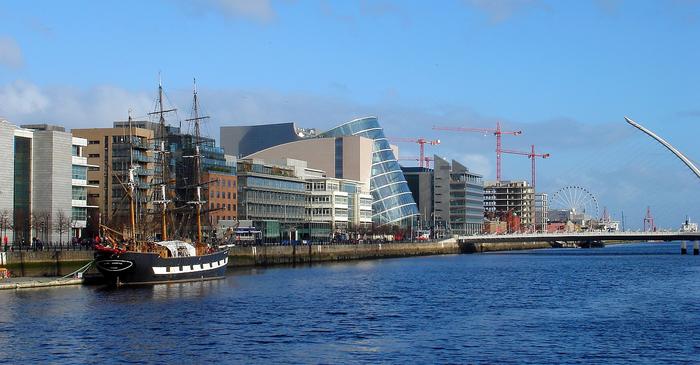
Dublin, Ireland. Location of the Oceans Past III conference, attended by LAMP’s Brendan Burke.
St. Augustine’s shrimping heritage is not typically the topic of conversation in European universities, but last week it was part of a scholarly gathering within the stone walls of an ancient university in Dublin, Ireland. Trinity College, founded in 1592, hosted scholars from twenty one countries to share the results of their research on historic fisheries throughout the world. Read on for more information about the Oceans Past III Conference!
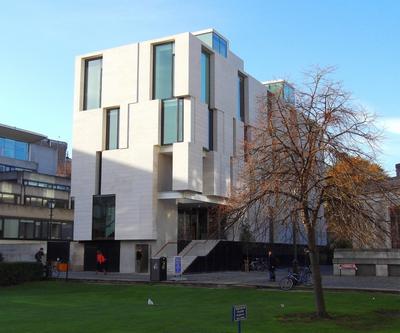
The Long Room Hub, Ireland’s newest academic building and the home of the HMAP project. Paneled in walnut and stone, the conference was held on the second floor.
For the past ten years, a program administered by the Census of Marine Life called the ‘History of Marine Animal Populations’ project has been gathering data on historic fishing and historically exploited marine species to try and understand how humans interact with the sea. While we may understand a great deal about the world around us we do not always understand how we arrived here. A basic concept of this conference was to understand how humans have used the seas in the past and what it has been, and may no longer, be capable of producing. So why was a member of the LAMP team in Dublin meeting with a bunch of fisheries biologists, historians, ecologists, geneticists, and genomics experts? I presented a paper entitled “Nothing So Small as a Shrimp; A Cultural Exploration of the Exploitation of Warmwater Shrimp along the Southeastern United States” My research over the past two years has focused on the shrimp industry, an industry with strong roots in St. Augustine and which is now in decline. I had submitted an abstract for approval almost a year ago and wanted to see how my approach compared to others.
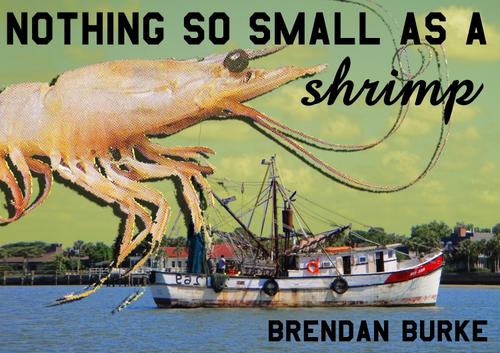
Titlepage of the presentation.
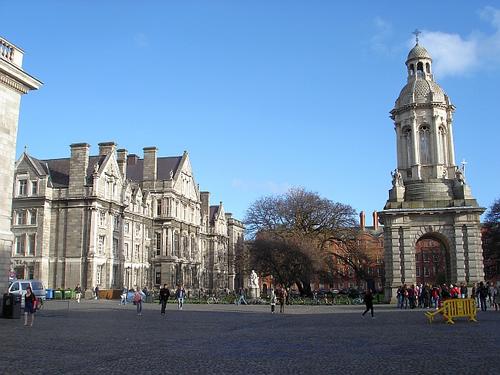
A view of the Trinity campus.
In attending, my goals for the conference were to listen and learn to and from peers and bring back insights on how to approach the study of marine populations with a historic and anthropological viewpoint. As much, it was also to present my own findings and add what twigs I could to the scholarly fire. My paper was scheduled for the final day of the conference and so I had an opportunity to listen in on most of the presentations. The conference hosted a healthy contingent of labcoat-types. A constant barrage of tables, modeling formulae, and theoretical representations used to back-calculate historical biomasses was, at time, overwhelming and I began to long for the simple and melodious tones of anthro-speak. By day two I was awarded with presentations on ethnographic study of the sea-sponge (trepang) industry in the Sulu/Sulawesi Sea, the chronicles of Georg Stellar and his Aleutian explorations, as well as plenty of numero-verbosity. Not to dispel the hard science, one of the primary goals of the conference is to engender cross pollination between the multiple sciences at play. In other words, maybe enumerative and model-driven insight could benefit an anthropological study of shrimping. Why not? Similarly, maybe ethnographic data or archaeological inquiry can benefit and enrich genetic studies of fish populations by adding provenienced datasets and additional cultural context.
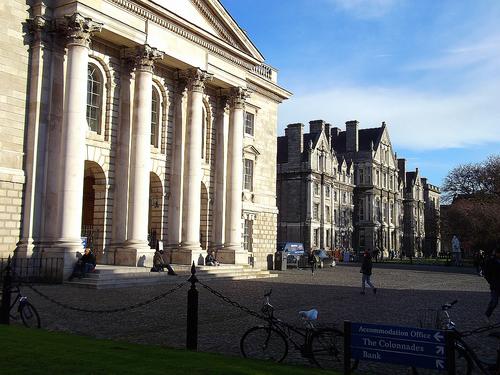
The species under scrutiny were as diverse as my tiny shrimp to whales and as geographically disparate as the Barents Sea from the coastline of Western Australia. It was fun too, to be in a room filled with almost as many languages as there were people. Fortunately, the lingua officia was English.
A highlight from the conference was our dining with Trinity College Fellows in their exquisite dining hall. This was not your usual college dining experience and one that I want to share with you. We were guests of the university and were asked to arrive promptly by 6:00pm. We entered the grandiose 18th century stone building and waited in a stark ante-room for the doors to open. A few minutes prior to the hour the doors were swung open to reveal a lavish and ancient dining hall. Three oak tables a hundred feet long provided seating and were immaculately set. Waiters, all dressed in black, stood by the 20’ high walnut paneling, to serve the first course. No one would be served, however, until the black-robed fellows strode in parade-fashion and took their seats at the head table. Fellows consist of special visiting scholars to the university, PhD candidates receiving certain scholarships, and other brass from the universities colleges. The main doors were slammed shut to echo loudly against the 40’ ceiling and 6’ tall paintings of former monarchs, scholars, and regents. This cannon-like shot announced to all to remain standing and be silent for the grace. Presented from a lectern in Latin, once grace was spoken the screech of chairs being pulled-to announced the beginning of the first course.
A hearty Irish vegetable stew was served with warm bread and Guinness. Then roast beef, green beans and potatoes for the main course, and a cherry crème brulee and hot tea did quite nicely for dessert. All served efficiently and professionally by the wait staff. This was a nice time for the conference attendees, approximately seventy of us, to enjoin in a bit of ceremonious revelry as well as to get to know each other outside of formalized sessions. In exactly fifty-minutes, the screech of chairs announced that it was time for the benediction, also in Latin. The regents paraded out while we all stood to attention, as thanks for our meal, and we followed them out into the crisp Dublin night. What a superbly old-world feeling the whole affair had!
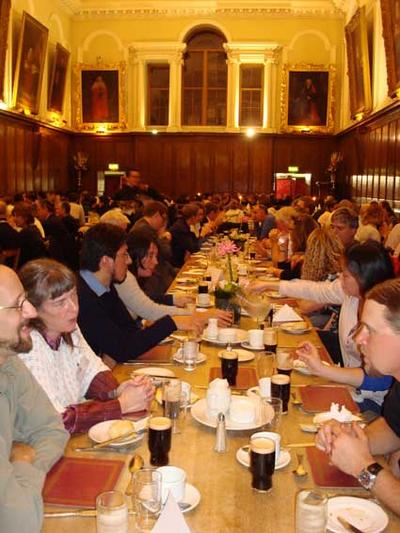
Trinity Commons
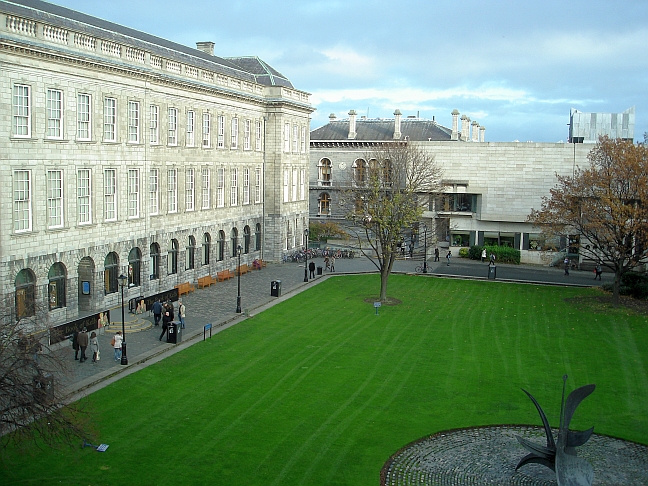
Trinity College, Dublin, location of the Historic Marine Animal Population Conference attended by Brendan Burke.
Friday night was much more informal as we met as a group in Messrs. Macguire, a pub by the River Liffey, in the heart of Dublin to discuss the conference, enjoy the evening, and tap a barrel of Guinness. I had a chance to share a pint and converse with my fellow conferees, a couple of which were from Mexico’s coast and who studied the traditional practice of harvesting sea turtles. My presentation was delivered on Saturday morning so the evening wasn’t too raucous or too late but altogether much fun. Other presentations addressed the historic trawling industry in Hull, England, a series of fishing vessel founderings in the north Atlantic during the 1960s, Saturday afternoon ended the conference with the final address and many cards exchanged as new networks were established and old ones renewed. The entire experience was absolutely positive. Every so often it is imperative for a researcher to meet with his/her fellows and compare notes on questions, methods, and results. More so than reading journals you get a chance to directly interact as a group of common interests. And as such, I consider the Oceans Past III conference a success!

The conference poster.
I want to thank the St. Augustine Lighthouse and LAMP for supporting my research and providing me a scholarly home, to all of the community members who have shared (and continue to share) their histories with me, and to Chesapeake Technologies LLC. for funding and making this experience possible.

